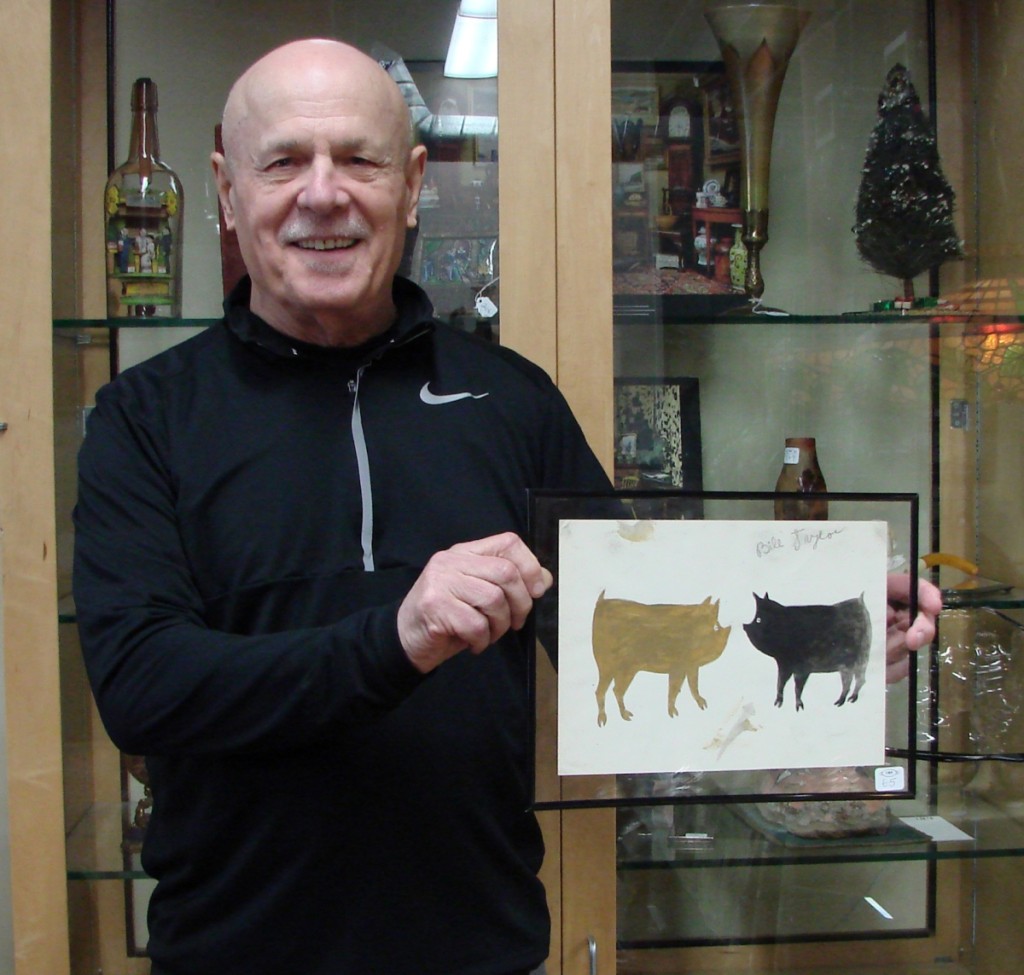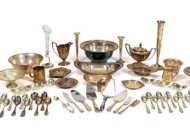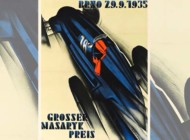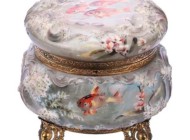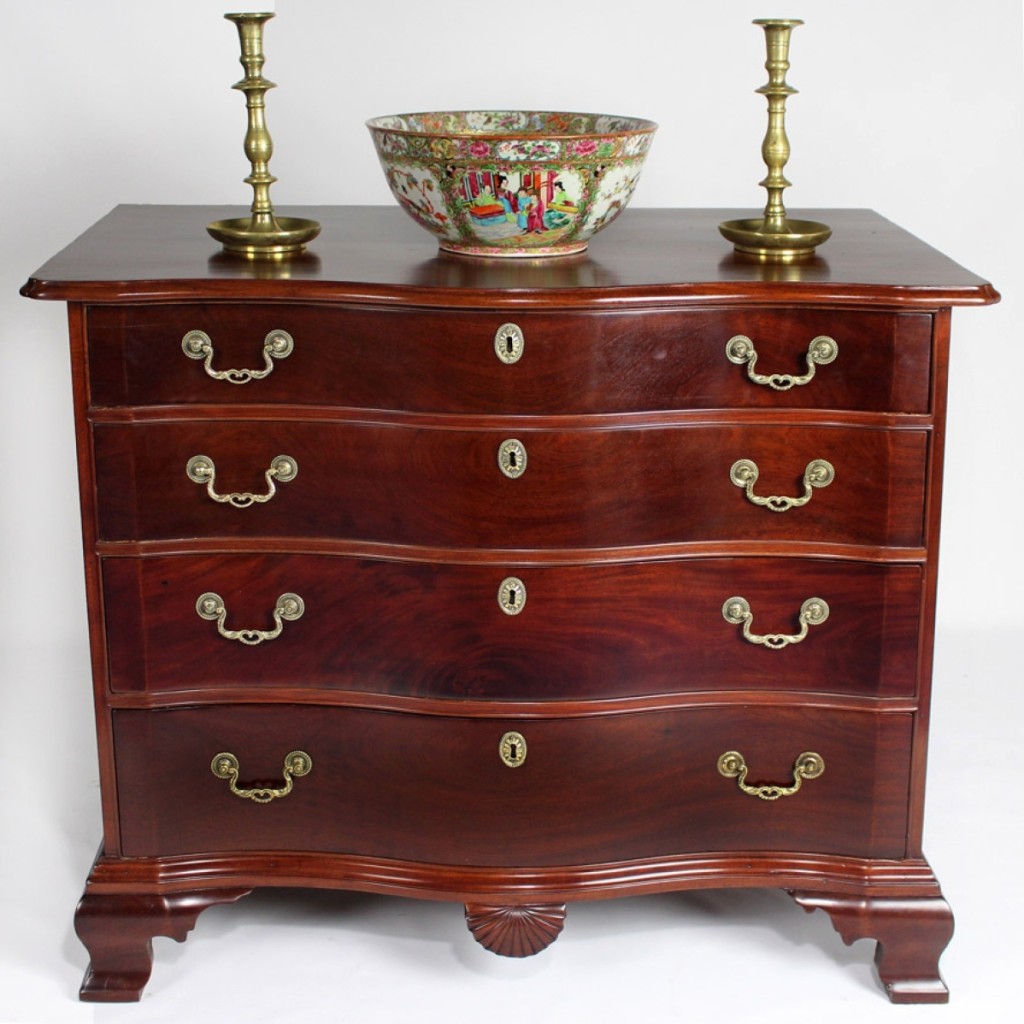
Probably the biggest surprise of the auction was the $27,600 brought by this Salem Chippendale serpentine front four-drawer chest. It had been heavily refinished and carried a high estimate of $5,000, but three phone bidders battled it out.
Review and Onsite Photos by Rick Russack, Additional Photos Courtesy CRN Auctions
CAMBRIDGE, MASS. — While Carl Nordblom was conducting his January 14 sale, he said, “This is like the old days.” He was right — many items sold well over the estimates, including a Chippendale serpentine front four-drawer chest that brought more than five times expectations. Paintings did well, a substantial collection of Nineteenth Century and Italian majolica performed admirably. The sale drew a large crowd, filling the gallery, and there were several phone lines in use, two internet platforms and numerous absentee bids. Very few items were passed.
A Bill Traylor (American, 1854-1949) watercolor and pencil work of a brown pig and a black pig looking at one another brought $37,200, more than 20 percent over the estimate. The watercolor was the last of three from a local collection. Nordblom had sold two others in his sale last September, those two bringing a combined total of about $70,000.
Leading the selection of American furniture was a Chippendale serpentine front mahogany chest with four graduated drawers. It had original brass, a fan carved drop and bold ogee feet. It had been heavily refinished, however, and was estimated to bring between $3,000 and $5,000. Three phone bidders competed until one was successful, paying $27,000. Some other pieces of American furniture did well, and some brought less than they probably should have.
On the plus side was a Nantucket Federal period mahogany and lacewood candlestand, which more than tripled its estimate, finishing at $5,750. Lacewood is an exotic wood not native to the United States, perhaps finding its way to Nantucket on returning whalers. The candlestand had fan-inlaid cut corners and a compass inlay to the top. It was attributed to Herman Ellis (1777-1816). A pair of Newport Chippendale mahogany side chairs, Goddard-Townsend school, earned $7,200. One was period and the other a bench-made copy. Somewhat disappointing was an Eighteenth Century Salem Chippendale oxbow secretary/bookcase with pierced fretwork above its figured mahogany doors. It sold well below the low estimate, a bargain for someone at $2,640.
European and Asian furniture drew active bidding. There were three pieces of heavily carved Anglo Indian ebony furniture that drew multiple phone and internet bidders. Each of the three pieces came from a descendant of the Brown family of Newport, R.I., and Nordblom had found them in an attic. All were dated about 1840 and made on the Coromandel Coast, part of the Indian subcontinent. A marble top commode with four carved drawers, carved feet, a carved gallery with an inset mirror, topped the group, finishing at $2,760. A matching cabinet, also with a marble top, brought $1,140 and a full-size bed with carved headboard and footboard went for $1,560. An Irish George II carved mahogany marble top console reached $6,600, and an English George II burl walnut secretary/bookcase went for $3,000.
The collection of Nineteenth Century majolica was consigned by Steve Arkin, whose name may be familiar to bluegrass fans. He is a world-class banjo player who played with the “Father of Bluegrass,” Bill Monroe, for a summer while he was in college. He has played with numerous other bluegrass bands, and today plays with Northern Lights. In 1964, he won the first prize at the Philadelphia Folk Festival banjo contest – the largest in the United States. He was an art history major, later working in marketing for Houghton-Mifflin. That job allowed him to travel widely, and 35 years ago he started buying studio-made Italian majolica, especially pieces made by Ulise Cantagalli (1839-1901).
Cantagalli worked in the Renaissance Revival style, and his studio in Florence produced authentic copies of Renaissance majolica using traditional methods. Nordblom had about 20 pieces to sell. Most were early examples of the studio’s work, marked only with a rooster and without the words “Made in Italy,” which would have had to be added after 1891 to comply with US import regulations. Arkin’s collection included works by several other majolica studios. An 8½-inch-high vase made by “Professor” Alfredo Santarelli, who opened his first studio in 1899 in Umbria region, went for $780. Santarelli received numerous awards during his lifetime.
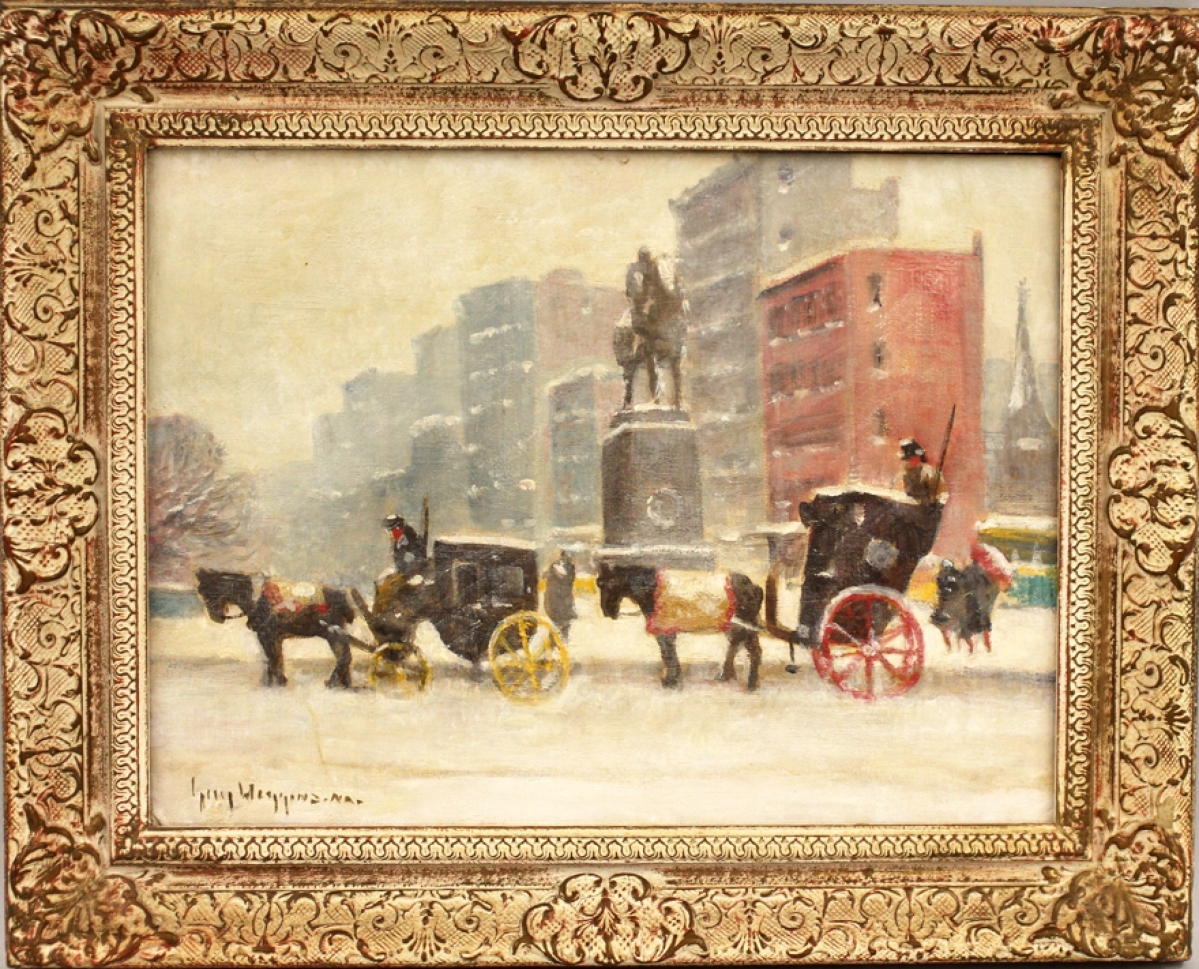
Winter scenes were popular with buyers. This one, by Guy Carlton Wiggins, “Winter at the Plaza,” depicted a scene in front of New York’s Plaza Hotel. It realized $15,600.
About a dozen Cantagalli pieces were bought by Mary and John McGuigan, collectors living in Maine. The couple was not outbid on any of the lots they wanted. Nearly all of the pieces sold within or slightly over estimate. But one piece, bought by the McGuigans, a 19½-inch charger with Candelieri style decoration depicting grotesques over a blue ground with lustre highlights, brought $7,200, more than double its estimate. The Fifteenth Century charger after which it was modeled is in the Getty Museum.
After the sale, the couple was asked why this particular piece did so well. John McGuigan said, “I’ve seen other examples of this piece but this one is the strongest. The Etruscan artists worked from a template but some were better than others. And it’s based on a piece in the Getty. We paid less than we had expected for some of the other pieces we bought, so we were able to stay with this one until we owned it.” The couple said they had been collecting Italian furniture and majolica for about 20 years. They recently built a home on the Maine seacoast, designed to house their collections.
It was a strong sale throughout, and the first lot indicated the way the day would go. It was an oil on canvas Boston winter scene by Arthur Clifton Goodwin (1864-1929) finishing well over the estimate at $6,600. Its provenance noted that it had been given by the artist to the consignor’s grandfather to settle a bar tab. There were other winter scenes and they appeared to be especially popular with bidders. A New York city scene, “Winter at the Plaza,” by Guy Carlton Wiggins (1883-1962) brought $15,600, and a winter scene of New York’s Wall Street by Johann Berthelsen (1883-1972) was bid to $7,200 from the same phone bidder. It was one of four paintings by the artist, all Impressionistic winter scenes of New York.
Also doing well was a watercolor and ink of a tree branch by British artist John Ruskin (1819-1900). It was framed together with a four-page letter written by Ruskin to his uncle in 1856, two photographs and a lithographed portrait of the artist. It sold for $12,000. The sale included some Art Deco period bronzes. “Snake Dancer” by Otto Poertzel (German, 1876-1963) earned $10,200. While selling a Modernistic abstract bronze by Dorothy Dehner (American, 1901-1994) Nordblom told the crowd, “No one did their homework on this one” as he knocked it down for $2,280.
After the sale, Nordblom said, “There were multiple bidders on most lots, many went over our estimates, and the room was packed. I was surprised by the serpentine chest, but that’s the fun of auctions. I’m glad the Traylor did well. It was last of the three that we had to sell – wish there were a few more. I’m very satisfied.”
Prices reported include the buyer’s premium.
For additional information, www.crnauctions.com or 617-661-9582.

